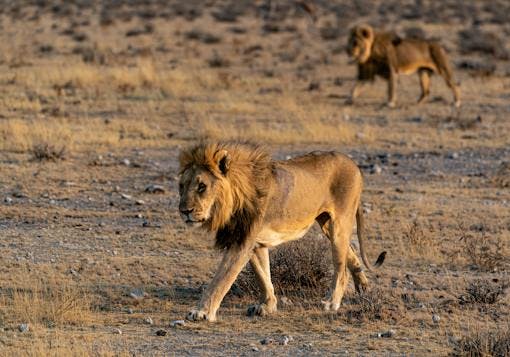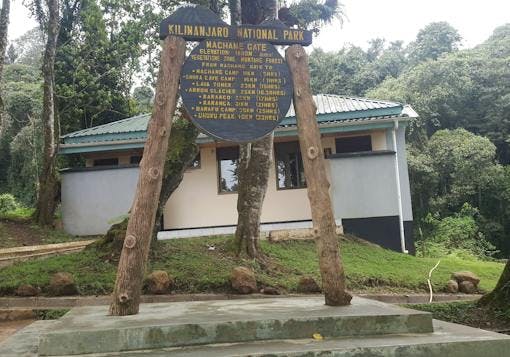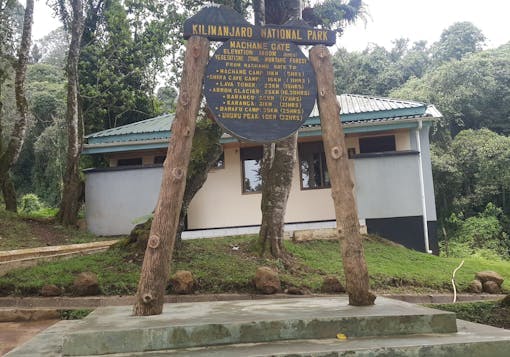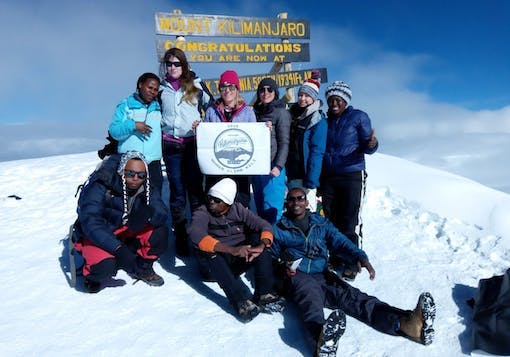Sustainable Travel Guide: Tanzania
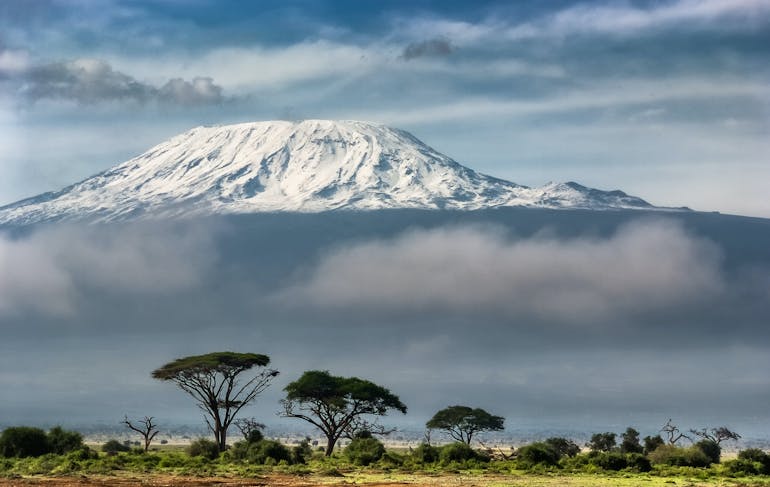
31
Jul
Sustainable Travel Guide: Tanzania
In this travel guide, you will discover everything you need to know about sustainable travel in Tanzania. You will find an overview of Tanzania’s iconic environment and landscapes. Following, our guide includes a rundown of Tanzania’s recent economic standing as well as its sociocultural background. We will share with you some important do’s and don’ts for tourists through a sustainable lens that will help you prepare for your visit. We also highlight various sustainable activities and trips.
Sustainable Travel in Tanzania: Key Pillars
Environmental
When tourists dream of the African continent, they often imagine warm savannahs sprinkled with the most impressive wildlife diversity. These features are exactly what Tanzania is made of and is exactly why it is an extremely popular tourist destination.
Tanzania is one of the largest countries in East Africa. It houses the highest point in Africa (Mount Kilimanjaro) and shares access to some of the largest freshwater lakes on the continent (including Lake Victoria and Lake Tanganyika). This means that the highest and lowest points of Africa can be found in Tanzania, allowing the country to have some of the most unique ecosystems in the world.
These dramatic geographical features are part of the Great Rift Valley, formed by a historic separation of tectonic plates. Thanks to the widening of these plates, Tanzania now has the perfect landscape to attract iconic wildlife including big cats, giraffes, zebras, and elephants. Game animals are drawn to the woodlands, the plateaus, the grasslands, and the freshwater.
According to the World Bank Group's Tanzania 2019 Country Environmental Analysis:
Around 1/3 of the country’s lands are under environmental protection.
Tanzania has 19 national parks (including Serengeti National Park - you might have heard of it) and 25 game reserves.
Even though Tanzania shares a border with eight other countries, it also has a beautiful coastline. The archipelago of Zanzibar (Unguja in Kiswahili) has become quite popular for its white sand beaches and turquoise waters. Located in the Indian Ocean, you can explore the other side of the biodiversity in Tanzania - the marine life. It is one of the most famous dive sites in the world where marine enthusiasts are blessed with ancient coral reefs, shipwrecks, and over 500 species of fish.
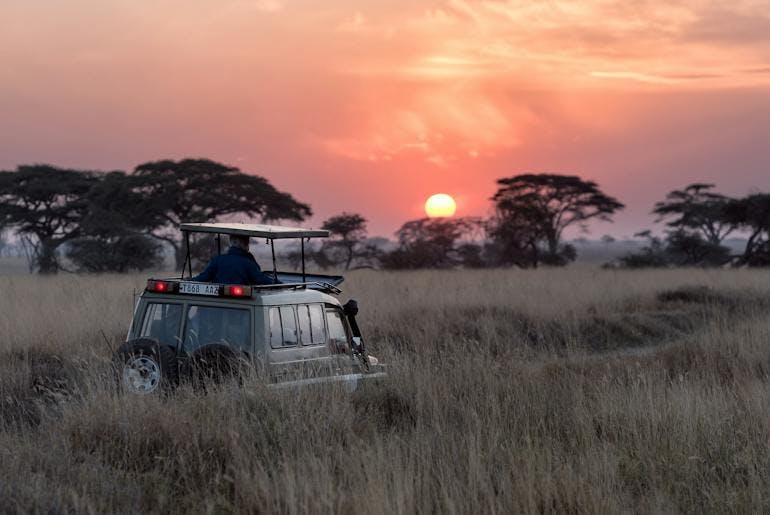
A safari jeep in the savannah at sunset.
Economic
Tanzania was one of the only economies in the world not to fall into recession after COVID-19, and it continues to be one of the fastest-growing economies in Africa. Despite this impressive growth, Tanzania continues to have a high poverty rate of 27% as well as one of the highest population growth rates in the world. More than 70% of the population is found in rural regions and is left with little access to resources and healthcare.
Tanzania’s economy is very dependent on agriculture. It is the country's main source of employment and exports. Most recently, farmers have been facing challenges due to climate change and financing.
Tourism is another essential part of the country’s economy, employing 10% of the population. Of course, COVID-19 impacted this industry; however, more recently, the ongoing war in Ukraine is impacting the economy. Eleven percent of the tourism in Tanzania previously came from either Russia or Ukraine. Despite this, the country earned the title of Africa’s Leading Destination in 2021. And, the industry saw a 57.7% increase in other tourist arrivals in 2022 compared to 2021.
Tourists have been attracted to the sustainable travel options in Tanzania. (Find a list of sustainable travel activities below!)
Fun fact: Yugen Earthside’s local partner in Tanzania created their company partially to combat the unemployment problem, and provides jobs for more than 400 locals!
Sociocultural
Tanzania’s culture is made up of over 120 tribes, making it one of the most diverse in the world! One of the most well-known is the semi-nomadic Maasai tribe from Northern Tanzania and many parts of Kenya. They have a reputation for preserving their traditional practices and their iconic colorful clothing. In recent years, Maasai families have been relocated due to increased wildlife and environmental conservation, causing notable tensions.
As a result of Tanzania’s cultural diversity, there are over 120 languages in Tanzania. The country has adopted Kiswahili (also known as Swahili) as its official language, and it is now being widely taught in schools along with English. As unifying as this is, it also means that many traditional practices and languages are starting to be lost.
The majority of the population in Tanzania is either Christian or Muslim. In fact, Tanzania is known as being a very conservative country which tourists need to be aware of and respect while visiting. (Find a full list of do's and don’ts below!)
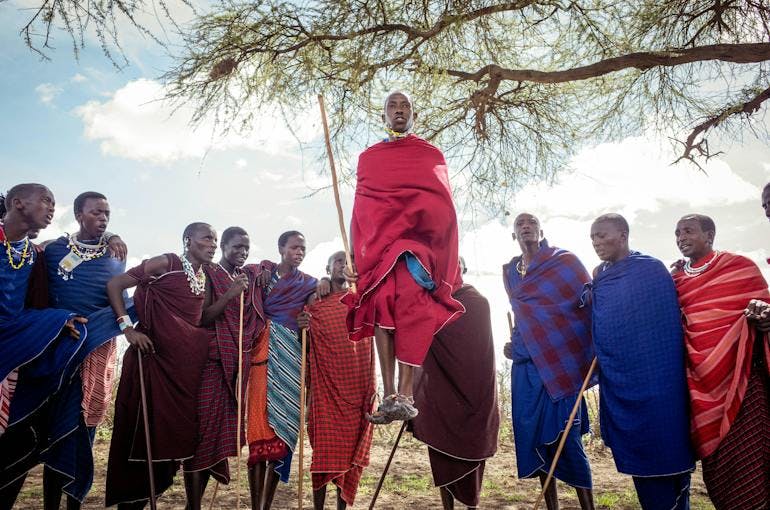
Colorfully dressed Maasai tribe members in the midst of a jumping dance.
Sustainable Travel in Tanzania: Everything Else
Healthcare
Tanzania’s healthcare system is classified as weak despite funding from international sources. They are working towards universal healthcare but access to healthcare is very scarce. The country currently has a high child and maternal mortality rate and HIV/AIDS is the leading cause of death. Pneumonia, tuberculosis, and malaria are other ailments of concern.
Tourists should consult their doctor at least one month prior to traveling to Tanzania to ensure they receive appropriate vaccinations. According to the CDC, some vaccines may include malaria, typhoid, and yellow fever.
Safety
Crime is something tourists should be aware of upon traveling to Tanzania. As Tanzania is a very conservative country, members of the LGBTQ community should be especially cautious. Several governments, including the United Kingdom and the United States, advise against travel to southern Tanzania towards the Mozambique border due to threats of terrorism.
Tourists should mainly be aware of petty crimes such as bag snatching and theft. Visitors should not walk closely to roads as bag snatching from passing vehicles or motorbikes is quite common. (Find a full list of do’s and don’ts below!)
Seasonal
There are two rainy seasons in Tanzania; the long rains and the short rains.
- March to May: The long rains take place from March to May. This rainy season is often very heavy and it is quite humid and hot.
- June to October: The dry season lasts from June until October. Precipitation and temperature vary based on altitude and location but generally, everything is a lot more comfortable during this time. This is typically considered to be the ‘ideal’ time to visit Tanzania.
- November to February: The short rains take place from November through to December. During this time, the rains are much lighter and eventually taper into the dryer months of January and February.
Many tourists plan their visit to Tanzania based on the Wildebeest migration. It is difficult to predict when exactly the migration will take place from year to year. However, it is understood that the Wildebeest migration takes place at the end of the long rains in May or June. To know more details, experts will share their predictions a year or two in advance which can easily be found online.
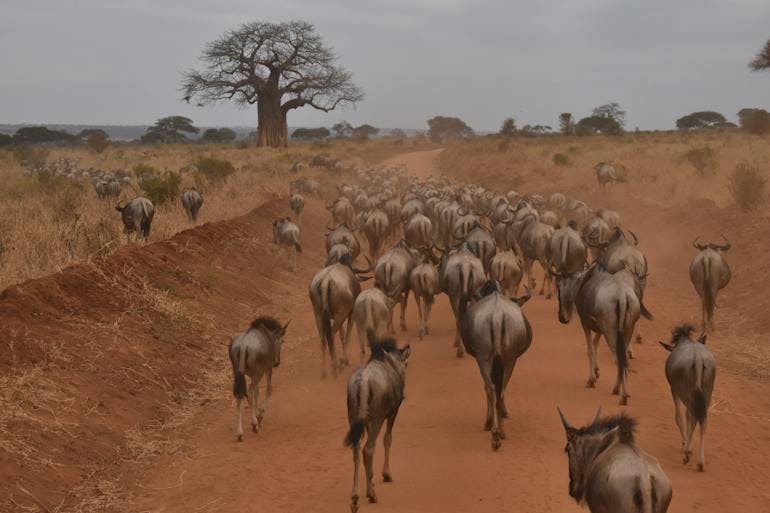
The yearly migration of the Wildebeest.
Holidays
Holidays in Tanzania are generally either religious or politically based. The country celebrates major Muslim and Christian holidays such as Easter, Christmas, Ramadan, and Eid. Tanzania National Day on December 9th celebrates Tanzania’s independence from British rule in 1961. Union Day on April 26th celebrates the union of Zanzibar and Tanganyika (now called Tanzania). Another important public holiday is Zanzibar Revolution Day which takes place on January 12th. This day remembers the revolution that led the way toward the country’s union. You can refer to this list to learn about all of the public holidays that take place in Tanzania.
Sustainable Travel in Tanzania: Do’s and Don’ts
What to do in Tanzania:
- Always be aware of your surroundings. Be especially alert when in busy locations as this is where theft can take place.
- Leave your passport and extra cash in the hotel safe that is bolted to the hotel’s furniture.
- Walk at least a long arm’s length away from the road, toward traffic. Remember, theft often takes place from vehicles passing by.
- Carry a photocopy of your IDs and visas (and remember to leave the originals in the safe).
- Ensure windows and doors are locked at all times, especially at night.
- Make sure your knees and shoulders are covered in public and that your clothes aren’t too form-fitting (this applies to both men and women).
- Make sure you are properly vaccinated and consult your doctor at least one month prior to visiting.
- Greet those older than you by saying shikamoo. Community elders are highly respected and you can bow and hold your right elbow to show your respect while shaking their hand.
- Follow the rules of the National Parks and Reserves. Be sure to respect the animals: you are a visitor and this is their home. Leave nothing behind after your safari.
- Sustainable travel in Tanzania is not complete without managing your water consumption! Water is a rare and valued resource in Tanzania - do not waste it! Conserve water by taking shorter showers and reusing towels.
- Bring a reusable water bottle with a built-in filter.
- During your stay, turn off the lights and fans when not needed. Utilize natural light and ventilation instead!
- Always choose eco-friendly accommodations and ethical tours!
What NOT to do in Tanzania:
- Do not use unlicensed taxis. Instead, arrange a taxi through your hotel or a reputable location.
- Do not walk around at night or alone.
- Avoid leaving food or drink unattended.
- Avoid public displays of affection (applies to all types of couples, even newlyweds!)
- Avoid carrying a bag, and do not carry a lot of cash at one time.
- Do not jump straight into conversation, always take the time to greet someone properly. Greetings are very important in Tanzanian culture.
- Do not take photos of someone without their permission. If you plan on visiting a Maasai village, they will most likely expect a tip in exchange for a photo.
- Do not touch other people or food with your left hand - this is often the case in Muslim countries. The left hand is considered dirty and should be used for cleaning yourself.
- Do not drink or brush your teeth with tap water. You should also not eat ice, salad, raw veggies, or fruit as they could be rinsed with tap water. When in doubt, ASK!
- Do not bring plastic bags, the country has banned plastic bags and is working towards being plastic-free!
- Avoid buying souvenirs that are made of animal skins or horns. Instead, you can purchase local textiles (such as a kanga - a traditional, colorful wrap), art, or ceramics.
Sustainable Travel in Tanzania: Activities
Safari and Wildlife Spotting
As you can probably guess, this is the most popular activity when visiting Tanzania. And rightfully so - going on a safari is a unique and exciting experience! People rush to the Serengeti and Ngorongoro Conservation Area for the chance to witness the “Big 5” (lions, leopards, rhinoceroses, elephants, and African Buffaloes) in their natural habitat.
While Serengeti and Ngorongoro are quite well-known, one sustainable choice you can make is to visit lesser-known national parks. Manyara and Tarangire National Parks are also nearby and can be visited with generally fewer tourists than Serengeti and Ngorongoro.
You should absolutely never participate in off-roading, hunting, or poaching. Safaris should be responsible and ethical towards wildlife and their employees. This includes viewing game animals from a safe distance, not feeding or petting them, staying on main roads with your driver and guide, staying in eco-friendly lodges, and tipping your driver and guide fairly.
Patience is key on a safari! Many trips include game drives at different times of the day so you can see a variety of wildlife.
Trekking Kilimanjaro
If you love the taste of adventure, trekking Kilimanjaro is a wonderful option for active travelers. Mount Kilimanjaro is one of the Seven Summits, making it one of the highest mountains in the world. It can often be accomplished in 6-7 days, though 8-10 day routes exist as well. Difficulty level is based on two variables: the route chosen, and the length of the trek (we can help you sort through options).
The Machame Route, also known as the Whisky Route, is the most popular path for visitors climbing Kili. This also means that it is usually the most crowded. However, there are many other routes you can take up the mountain: Lemosho, Rongai, Shira, Umbwe, Marangu, Northern Circuit, and Crater Camp.
A sustainable travel choice you can make is to take one of these alternate routes when trekking Mount Kilimanjaro in Tanzania. You will still earn great views, enjoy a low-carbon impact experience, and have a more serene journey on the trail.
- All 6-7 day climb routes: Machame, Lemosho, Rongai, Shira, Umbwe, and Marangu.
- All 8-10 day climb routes: Lemosho, Northern Circuit, Crater Camp.
Conquering Kili should only be done with a guide and local porter. As always, make sure you leave no trace of your trek and book your tour with an ethical tour operator. For instance, verify that your tour operator is a member of the Kilimanjaro Porters Assistance Project. They ensure that porters and other crew members are paid fair wages and are treated fairly during their climb.
We also offer a Women-Only Kilimanjaro Trek and Safari, click here to learn the details!
Enjoy Zanzibar
If relaxing at the beach is more your style, Zanzibar - Tanzania's island sitting just off its eastern coast - should be added to your list! The white sandy beaches of Zanzibar are famously known as the perfect honeymoon destination. There are so many ways tourists can enjoy the warm, tropical turquoise waters. Snorkeling, scuba diving, and sailing are just to name a few.
Here are some tips for sustainable travel in Zanzibar:
- Keep the beaches as clean or cleaner than you found them.
- Be respectful of Tanzania's conservative nature by wearing the proper clothing. On the beach, this means no thongs and no going topless.
- Use reef-safe sunscreen, and never take anything (including shells) from the ocean.
You can read more tips on how to make your beach day in Zanzibar sustainable here!
If interested in traveling to Zanzibar, ask us about our 4-day responsible package trip to Stone Town or our 7-day responsible package trip along Zanzibar’s northeastern coast (budget and mid-range pricing available).
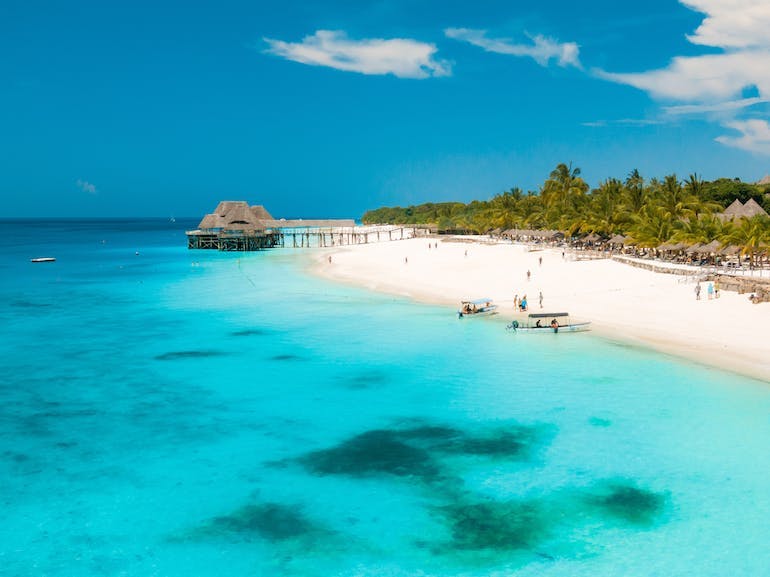
Zanzibar's white sand beaches and turquoise waters.
Tanzania as a Sustainable Travel Destination
Tanzania has taken great strides toward being a sustainable travel destination. As mentioned above, they have banned plastic bags and there are many initiatives towards assisting locals including the Kilimanjaro Porters Assistance Project. Lonely Planet states:
[Tanzania is] one of the top 10 countries in the world in terms of conservation, making it one of the best destinations for eco-tourism.Lonely Planet
So, sustainable travel in Tanzania can be achieved in many ways, whether you’re looking for safaris and wildlife viewing, adventurous climbs up Mount Kilimanjaro, or immersive cultural and coastal tours in Zanzibar!
We, as tourists, have the responsibility to engage and respect Tanzania’s sustainability efforts by leveraging ethical companies and tours. Sustainable travel in Tanzania is entirely possible by doing the proper research. Always ensure the environment and people of the country you’re visiting are protected and respected. It is the least you can do for the ability to witness such incredible landscapes up close!
This post may contain affiliate links. This means we may earn a small commission if you purchase a product from our link, at no additional cost to you.
